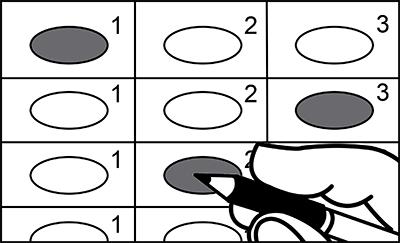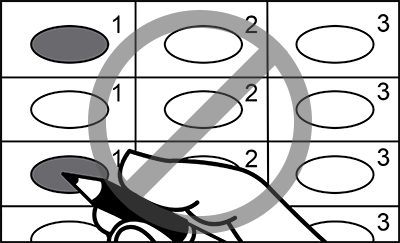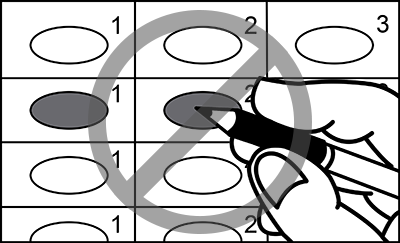Elections
Ranked Choice Voting
Ranked Choice Voting (RCV) is a type of ranked preferential voting. The Utah State Legislature made RCV possible for municipal elections in Utah with the passing of HB 35, the Municipal Alternative Voting Methods Pilot Project.
Several municipal legislative bodies (councils/mayors) in Salt Lake County have opted to hold ranked choice elections for 2023.
To practice ranked choice voting on a sample ballot, visit our Ranked Choice Voting Online Tool
What is Ranked Choice Voting?
According to Ballotpedia:
A ranked-choice voting system is an electoral system in which voters rank candidates by preference on their ballots. If a candidate wins a majority of first-preference votes, he or she is declared the winner. If no candidate wins a majority of first-preference votes, the candidate with the fewest first-preference votes is eliminated. First-preference votes cast for the failed candidate are eliminated, lifting the second-preference choices indicated on those ballots. A new tally is conducted to determine whether any candidate has won a majority of the adjusted votes. The process is repeated until a candidate wins an outright majority.
To learn more about how RCV will work in Salt Lake County, please review the resources below.
RCV Resources
In ranked choice voting contests, the names of candidates are listed on the left side of the ballot, with ranked choices along the top. A grid of ovals is to the right of candidate names. This is where you will mark your choices.
Voters can rank all candidates in a contest using the columns on the ballot to indicate their choices. Voters may rank as many or as few candidates as they like. If a voter doesn’t wish to rank some of the candidates, they can leave any remaining columns blank. However, voters are encouraged to rank their choices in case their most preferred candidates are phased out.
To rank candidates on the ballot, fill in the oval that corresponds to your choice:
- In the first column for your first choice,
- In the second column for your second choice,
- In the third column for your third choice, and so on.

 |
Correct! All choices must be different. |
 |
Incorrect. Don't fill-in more than one oval per column |
 |
Incorrect. Don't choose the same candidate more than once. |
Download a printable practice ballot here.
In Phase 1 of ranked choice tabulation (vote counting), all first-choice votes are counted. If a candidate receives more than 50% of the votes, they win. If no candidate earns more than 50% of first-choice votes, the counting moves to Phase 2.
After each phase, the candidate with the fewest votes is eliminated. If your highest-ranked candidate is eliminated, your vote goes to the next highest ranked candidate on your ballot.
The tabulation process continues through as many phases as necessary to choose a winner. Once there are only two candidates left, the candidate with greater than 50% of the votes is the winner.
It’s important to remember that your vote for your second-choice candidate is only counted if your first choice is eliminated. If both your first and second choices are eliminated, your vote is counted for your next choice, and so on.
Ranked choice elections are currently only allowed in Utah for municipal contests. Municipal legislative bodies (councils/mayors) in Salt Lake County make the determination whether to hold ranked choice elections. The list of ranked choice contests for the 2023 General Election is below:
- Midvale City Council District 1
- Midvale City Council District 3
- Millcreek Council District 3
- Salt Lake City Mayor
- Salt Lake City Council District 4
- Salt Lake City Council District 6
- South Salt Lake Council At-Large
Do I need to rank all candidates?
No. You may rank as many candidates as there are in a race. If you do not want to rank some candidates, feel free to leave columns blank.
If I rank other candidates, does it affect my first choice?
No. Ranking other candidates does not affect your first choice. Only your first choice is counted in Phase 1. Your second, third, fourth, and other choices will be considered only if your first-choice candidate does not win.
How can my first choice be eliminated?
If no candidate receives more than 50% of first-choice votes, the last-place candidate is eliminated. If your first choice is eliminated as a result, your next choice will be counted, and so on. The process of elimination continues until there is a winner.
If I really want my first-choice candidate to win, should I rank the candidate as my first, second, and third choice, and so on?
No. Your vote can count only once for your first choice. If you rank the same candidate first, second, and third, it is the same as leaving the second and third choices blank.
Can I give multiple candidates the same ranking?
No. If you give multiple candidates the same ranking, this is called an “over-vote”. Your vote in that rank and later ranks cannot be counted.
If you have further questions about ranked-choice voting, contact the Salt Lake County Election Division at (385) 468-7400 or vote@slco.org
